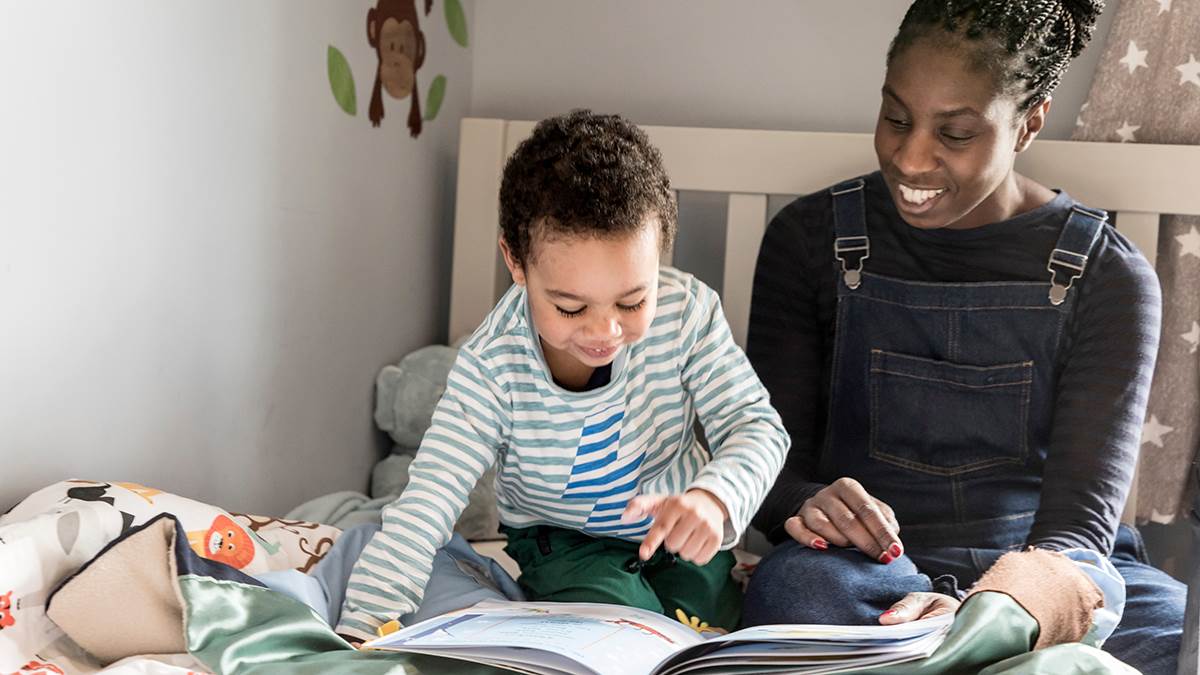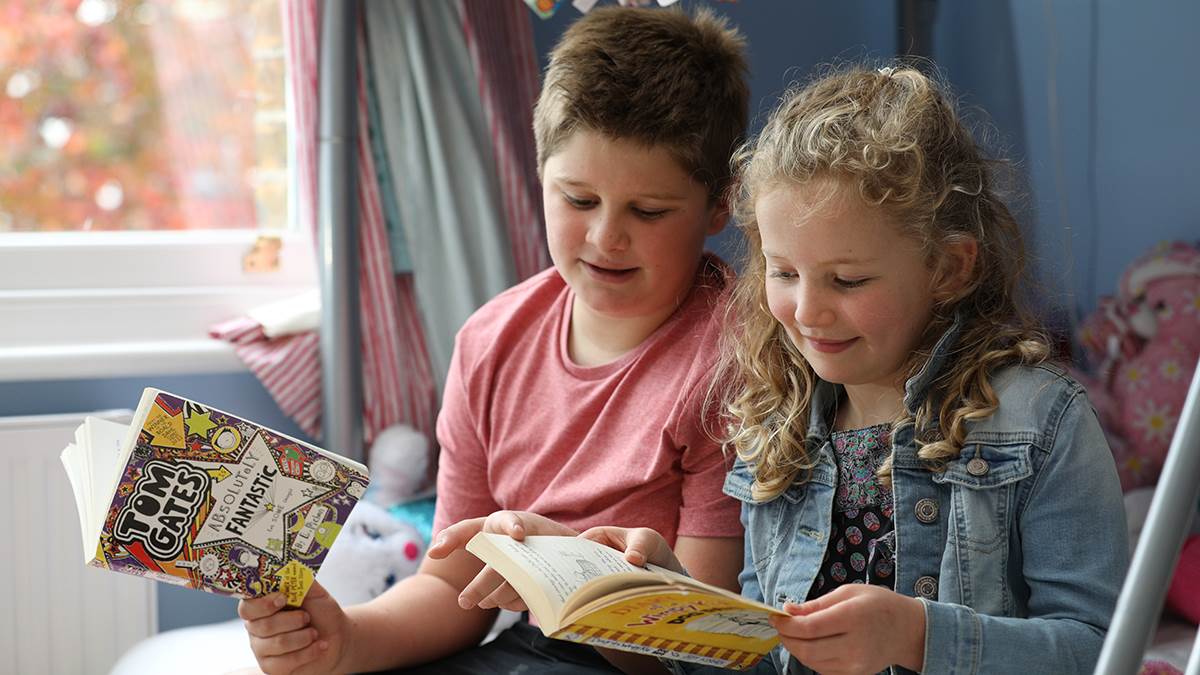Helping Your Child With Reading
Helping your child with reading
Our reading leaflets below tell you how best to support your child at home.
Here are 10 simple steps to teach your child to read at home:
1. Use songs and nursery rhymes to build phonemic awareness
Children's songs and nursery rhymes aren't just a lot of fun—the rhyme and rhythm help kids to hear the sounds and syllables in words, which helps them learn to read. A good way to build phonemic awareness (one of the most important skills in learning to read) is to clap rhythmically together and recite songs in unison. This playful and bonding activity is a fantastic way for kids to implicitly develop the literacy skills that will set them up for reading success.
2. Make simple word cards at home
Cut out simple cards and write a word containing three sounds on each one (e.g. ram, sat, pig, top, sun, pot, fin). Invite your child to choose a card, then read the word together and hold up three fingers. Ask them to say the first sound they hear in the word, then the second, and then the third. This simple activity requires little prep‑time and builds essential phonics and decoding skills (helping them learn how to sound out words). If your child is just starting out with learning the letters of the alphabet, focus on the sound each letter makes, more so than letter names.
3. Engage your child in a print-rich environment
Create daily opportunities to build your child's reading skills by creating a print‑rich environment at home. Seeing printed words (on posters, charts, books, labels etc.) enables children to see and apply connections between sounds and letter symbols. When you're out and about, point out letters on posters, billboards and signs. In time you can model sounding out the letters to make words. Focus on the first letter in words. Ask your child “What sound is that letter?” “What other word starts with that sound?” “What word rhymes with that word?”
4. Play word games at home or in the car
Building on from the previous step, introduce simple word games on a regular basis. Focus on playing games that encourage your child to listen, identify and manipulate the sounds in words. For example, start by asking questions like “What sound does the word start with?” “What sound does the word end with?” “What words start with the sound ?” and “What word rhymes with ?”.
5. Understand the core skills involved in teaching kids to read
It's important to remember that learning to read involves various different skills. There are five essential components of reading that you can read about here. These are the skills all children need in order to successfully learn how to read. In summary, these include:
- Phonemic awareness – the ability to hear and manipulate the different sounds in words
- Phonics – recognising the connection between letters and the sounds they make
- Vocabulary – understanding the meaning of words, their definitions, and their context
- Reading comprehension – understand the meaning of text, both in storybooks and information books
- Fluency – the ability to read aloud with speed, understanding and accuracy
6. Play with letter magnets
Middle vowel sounds can be tricky for some children, which is why this activity can be so helpful. Prepare letter magnets on the fridge and pull the vowels to one side (a, e, i, o, u). Say a CVC word (consonant-vowel-consonant), for example 'cat', and ask your child to spell it using the magnets. To help them, say each vowel sound aloud (/ayh/, /eh/, /ih/, /awe/, /uh/) while pointing at its letter, and ask your child which one makes a sound similar to the middle sound.
7. Harness the power of technology to keep your child engaged
Learning to read should be an enjoyable process in order to keep kids motivated to improve. Sometimes a child might be full of excitement and eagerness to learn at the beginning, but once they hit a wall can feel overwhelmed and give up easily. As a parent, it can feel impossible to pick up again and know where to fill in any gaps that may be causing frustration.
Reading Eggs uses self‑paced lessons that match each individual child's ability. Children are regularly rewarded for completing activities and reaching new levels, which keeps them motivated to stay on track. Parents can also view instant progress reports to see how a child's skills are improving.
8. Read together on a daily basis and ask questions about the book
A lot of people don't realise just how many skills can be picked up through the simple act of reading to a child. Not only are you showing them how to sound out words, you're also building key comprehension skills, growing their vocabulary, and letting them hear what a fluent reader sounds like. Most of all, regular reading helps your child to develop a love reading, which is the best way to set them up for reading success.
Strengthen your child's comprehension skills by asking questions while reading. For younger children, encourage them to engage with the pictures (e.g. “Do you see the boat? What colour is the cat?”). For older children, ask questions about what you've just read, like “Why do you think the little bird was afraid?” “When did Sophie realise she had special powers?”
9. Play games to memorise high-frequency sight words every day
Sight words are ones that cannot be easily sounded out and need to be recognised on sight. High‑frequency sight words are ones that occur very often in reading and writing (e.g. you, I, we, am, had, and, to, the, have, they, where, was, does).
The strategy for learning sight words is, "See the word, say the word". Learning to identify and read sight words is essential for young children to become fluent readers. Most children will be able to learn a few sight words at the age of four (e.g. is, it, my, me, no, see, and we) and around 20 sight words by the end of their first year of school. You can teach sight words by playing with flashcards and using reading programmes like Reading Eggs.
10. Be patient; the best way to teach kids to read is to make it fun!
Every child learns at his or her own pace, so always remember the single most important thing you can do is to make it enjoyable. By reading regularly, mixing things up with the activities you choose, and letting your child pick out their own books occasionally, you'll instil an early love of reading and give them the best chance at reading success in no time.
As your child gets a bit older
Sharing picture books can be a lot of fun – but don’t worry if your child gets distracted, chews the book or wanders off… that’s perfectly normal! Don’t worry if you don’t have a lot of time in your busy day, either – just a few minutes can make a huge difference.

Here are some more tips to help you enjoy storytime together:
- Ask your child to choose what they’d like to read. They’ll feel more interested in the story if they’ve picked it out themselves. (And don’t worry if they keep returning to the same story, either!)
- If you can, turn off the TV, radio and computer. It’s easier for both of you to enjoy the story without any other distractions.
- Sit close together. You could encourage your child to hold the book themselves and turn the pages, too.
- Take a look at the pictures. You don’t just have to read the words on the page. Maybe there’s something funny in the pictures that you can giggle about together, or perhaps your child enjoys guessing what will happen next.
- Ask questions and talk about the book. Picture books can be a great way to talk through your child’s fears and worries, or to help them deal with their emotions. Give them space to talk, and ask how they feel about the situations in the story.
- Have fun! There’s no right or wrong way to share a story – as long as you and your child are having fun. Don’t be afraid to act out situations or use funny voices… your little ones will love it!
Encouraging a love of reading
As children get older, with lots of other activities competing for their time, how can you encourage them to make time for reading?

Here are some of our ideas:
- Read yourself! It doesn’t matter what it is – pick up a newspaper or magazine, take a look at a cookery book, read a computer manual, enjoy some poetry or dive into a romance or detective novel. And get your children to join in – if you’re cooking, could they read the recipe? If you’re watching TV, can they read out the listings?
- Give books as presents. And encourage your children and their friends to swap books with each other – it’ll give them a chance to read new stories, and get them all talking about what they’re reading.
- Visit the local library together. It’s always fun choosing new books to read, and keep an eye out for special author events at the library or local bookshops – children love meeting their favourite authors. Jacqueline Wilson and Anthony Horowitz always have signing queues that are miles long!
- Encourage children to carry a book at all times. That way, they’ll never be bored (this is something you can do, too!)
- Have a family bookshelf. If you can, have bookshelves in your children’s bedrooms, too.
- Keep reading together. Just because your children are older, it doesn’t mean you have to stop sharing stories – perhaps you could try the Harry Potter series or A Series of Unfortunate Events.
- Don’t panic if your child reads the same book over and over again. Let’s be honest - we’ve all done it!
Please see our Kids Reading Zone for recommended books for each year group: http://www.holmeschapelprimary.org.uk/page/kids-reading/30543
Alternatively, visit our Reading page to find out more about how we teach reading in school: http://www.holmeschapelprimary.org.uk/page/reading-and-phonics/6155
